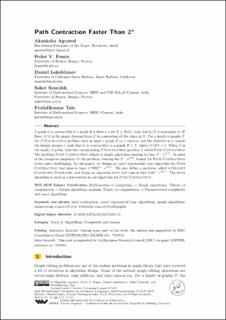| dc.contributor.author | Agrawal, Akanksha | |
| dc.contributor.author | Fomin, Fedor | |
| dc.contributor.author | Lokshtanov, Daniel | |
| dc.contributor.author | Saurabh, Saket | |
| dc.contributor.author | Tale, Prafullkumar | |
| dc.date.accessioned | 2020-08-07T13:09:31Z | |
| dc.date.available | 2020-08-07T13:09:31Z | |
| dc.date.issued | 2019 | |
| dc.Published | Agrawal A, Fomin V, Lokshtanov D, Saurabh S, Tale P. Path Contraction Faster Than 2n. Leibniz International Proceedings in Informatics. 2019;132 | eng |
| dc.identifier.issn | 1868-8969 | en_US |
| dc.identifier.uri | https://hdl.handle.net/1956/23578 | |
| dc.description.abstract | A graph G is contractible to a graph H if there is a set X subseteq E(G), such that G/X is isomorphic to H. Here, G/X is the graph obtained from G by contracting all the edges in X. For a family of graphs F, the F-Contraction problem takes as input a graph G on n vertices, and the objective is to output the largest integer t, such that G is contractible to a graph H in F, where |V(H)|=t. When F is the family of paths, then the corresponding F-Contraction problem is called Path Contraction. The problem Path Contraction admits a simple algorithm running in time 2^n * n^{O(1)}. In spite of the deceptive simplicity of the problem, beating the 2^n * n^{O(1)} bound for Path Contraction seems quite challenging. In this paper, we design an exact exponential time algorithm for Path Contraction that runs in time 1.99987^n * n^{O(1)}. We also define a problem called 3-Disjoint Connected Subgraphs, and design an algorithm for it that runs in time 1.88^n * n^{O(1)}. The above algorithm is used as a sub-routine in our algorithm for Path Contraction. | en_US |
| dc.language.iso | eng | eng |
| dc.publisher | Dagstuhl Publishing | en_US |
| dc.rights | Attribution CC BY | eng |
| dc.rights.uri | http://creativecommons.org/licenses/by/3.0 | eng |
| dc.title | Path Contraction Faster Than 2n | en_US |
| dc.type | Peer reviewed | |
| dc.type | Journal article | |
| dc.date.updated | 2020-02-14T16:15:18Z | |
| dc.description.version | publishedVersion | en_US |
| dc.rights.holder | Copyright 2019 The Author(s) | en_US |
| dc.identifier.doi | https://doi.org/10.4230/lipics.icalp.2019.11 | |
| dc.identifier.cristin | 1766805 | |
| dc.source.journal | Leibniz International Proceedings in Informatics | |
| dc.identifier.citation | Leibniz International Proceedings in Informatics. 2019, 132. | |

